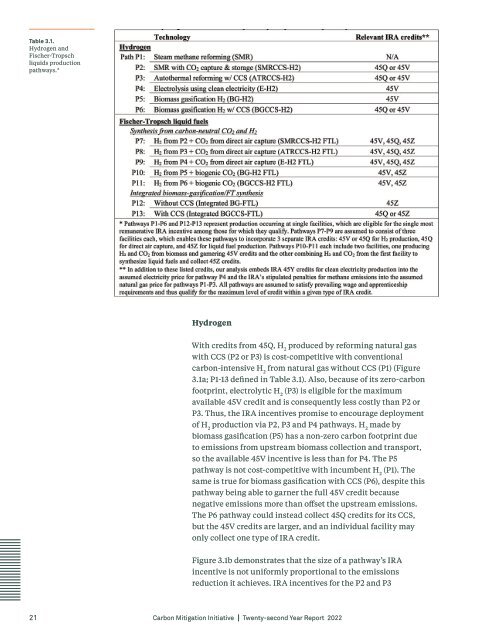CMI Annual Report 2022
You also want an ePaper? Increase the reach of your titles
YUMPU automatically turns print PDFs into web optimized ePapers that Google loves.
Table 3.1.<br />
Hydrogen and<br />
Fischer-Tropsch<br />
liquids production<br />
pathways.*<br />
Hydrogen<br />
With credits from 45Q, H 2<br />
produced by reforming natural gas<br />
with CCS (P2 or P3) is cost-competitive with conventional<br />
carbon-intensive H 2<br />
from natural gas without CCS (P1) (Figure<br />
3.1a; P1-13 defined in Table 3.1). Also, because of its zero-carbon<br />
footprint, electrolytic H 2<br />
(P3) is eligible for the maximum<br />
available 45V credit and is consequently less costly than P2 or<br />
P3. Thus, the IRA incentives promise to encourage deployment<br />
of H 2<br />
production via P2, P3 and P4 pathways. H 2<br />
made by<br />
biomass gasification (P5) has a non-zero carbon footprint due<br />
to emissions from upstream biomass collection and transport,<br />
so the available 45V incentive is less than for P4. The P5<br />
pathway is not cost-competitive with incumbent H 2<br />
(P1). The<br />
same is true for biomass gasification with CCS (P6), despite this<br />
pathway being able to garner the full 45V credit because<br />
negative emissions more than offset the upstream emissions.<br />
The P6 pathway could instead collect 45Q credits for its CCS,<br />
but the 45V credits are larger, and an individual facility may<br />
only collect one type of IRA credit.<br />
Figure 3.1b demonstrates that the size of a pathway’s IRA<br />
incentive is not uniformly proportional to the emissions<br />
reduction it achieves. IRA incentives for the P2 and P3<br />
21<br />
Carbon Mitigation Initiative Twenty-second Year <strong>Report</strong> <strong>2022</strong>
















